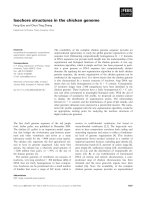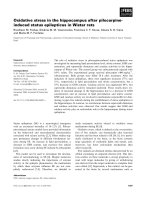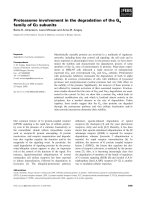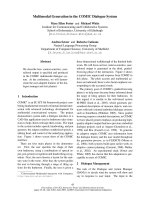Báo cáo khoa học: " Immune-Mediated Fever in the Dog. Occurrence of Antinuclear Antibodies, Rheumatoid Factor, Tumor Necrosis Factor and Interleukin-6 in Serum." ppt
Bạn đang xem bản rút gọn của tài liệu. Xem và tải ngay bản đầy đủ của tài liệu tại đây (65.62 KB, 7 trang )
Øvrebø Bohnhorst J, Hanssen I, Moen T: Immune-mediated fever in the dog. Oc-
currence of antinuclear antibodies, rheumatoid factor, tumor necrosis factor and
interleukin-6 in serum. Acta vet. scand. 2002, 43, 165-171. – Contents of antinuclear
antibodies (ANA), rheumatoid factor (RF), tumor necrosis factor (TNF-α) and inter-
leukin-6 (IL-6) were measured in serum from 20 dogs with immune-mediated fever.
Seven out of 20 patients were ANA positive, 1 out of 20 was positive to antibodies
against extractable nuclear antigens (ENA), 1 out of 20 was positive to antibodies
against deoxynucleoproteins (DNP), 2 out of 13 were RF positive and none out of 20 pa-
tients had antibodies against native DNA in the serum. TNF-α was not detected in any
serum of 15 dogs with immune-mediated fever, while 10 out of 13 presented with ele-
vated IL-6. The results varied between patients, but the IL-6 level was high in most of
them. This indicate a role for IL-6 in the pathogenesis of immune-mediated fever in
most cases.
dog; immune; fever; antinuclear antibodies; rheumatoid factor; tumor necrosis
factor; interleukin-6.
Acta vet. scand. 2002, 43, 165-171.
Acta vet. scand. vol. 43 no. 3, 2002
Immune-Mediated Fever in the Dog. Occurrence of
Antinuclear Antibodies, Rheumatoid Factor, Tumor
Necrosis Factor and Interleukin-6 in Serum
By J. Øvrebø Bohnhorst
1
, I. Hanssen
2
and Torolf Moen
1
1
Department of Immunology and Transfusion Medicine, University Hospital of Trondheim, and
2
Strinda Small
Animal Clinic, Trondheim, Norway.
Introduction
Fever of unknown origin (FUO) is not an un-
common problem in clinical canine medicine.
In human medicine the criteria which define
FUO are (1) prolonged fever of more than 3
weeks duration associated with non-specific
signs of illness such as lethargy, anorexia and
weight loss, (2) temperature at least 0.83°C
above normal on several occasions and (3) di-
agnosis still uncertain after one week of hospi-
talization and routine laboratory tests (Peters-
dorf & Beeson 1961,Vickery & Quinnell 1977,
Wolf & Dinarello 1979).
These criteria are not directly applicable to ca-
nine medicine, but may serve as useful guide-
lines to exclude fever of shorter duration asso-
ciated with infections. The definition of FUO in
dogs was expanded by Dunn & Dunn 1998 to
include dogs with temperature in excess of
40°C on more than one occasion.
In humans the relative frequencies of causes of
FUO are well established (Petersdorf & Beeson
1961, Jacoby & Swartz 1973), with the cases
being devided as follows: infection 40%, neo-
plasia 20%, immune-mediated 15%, miscella-
neous 20% and 5% remaining undiagnosed.
In canine medicine the relative frequency of
different causes of FUO varies between studies.
The distribution suggested by Feldman (1980)
was infections 40%, neoplasia 20%, immune-
mediated disease 20%, miscellaneous condi-
tions 10% and undiagnosed (true FUO) 10%.
Bennet (1995) claimed that infection is ac-
counting for 50%, immunemediated disease
40% and neoplasia 10% of cases with diag-
nosed causes of FUO.
Dunn & Dunn (1998) sorted 101 dogs with
FUO into 6 main groups with the following re-
sult: infections 16%, neoplasia 9.5%, immune-
mediated disease 22%, miscellaneous condi-
tions 11.5%, primary bone marrow ab-
normalities 22%, and true FUO 19%.
In the present study we have investigated the
occurrence of selected auto antibodies and 2 in-
flammatory mediators, interleukin-6 (IL-6) and
tumour necrosis factor (TNF-α) in serum from
dogs with fever that we eventually diagnosed as
immune-mediated.
The criteria for being included into the material
was fever above 39.9°C that did not respond to
2 successive treatments with different antibi-
otics, but to a subsequent prednisolone cure.
Materials and methods
Dogs
The material consisted of 20 dogs of 13 differ-
ent breeds. All dogs were brought to the clinic
within 3 days after they became ill. They were
submitted to general clinical examinations, and
separated into 3 groups based on clinical signs
(Table 1). One group showed only fever, while
the others who showed muscle pain and muscle
and joint-pain, respectively. Dogs included in
the latter 2 groups were stiff and lame. Pain
could commonly be located in the M. triceps
brachii and M. quadriceps femoris, and in the
elbow, carpal, stifle or tarsal joints. Neck stiff-
ness and pain were also observed, but not as
single sign. The fever was measured to lie be-
tween 39.9 and 41.4°C .
Blood specimen was drawn from a cephalic
vein and serum was prepared and kept frozen at
-20°C till the analyses were performed. The pa-
tients were first treated with phenoxymethyl-
penicillin and secondly trimetoprim /sulphadi-
azin in adequate doses, 2-3 days with each,
without clinical effect. Then they got pred-
nisolone, starting with 1mg/kg/day and tapered
down during a period of 2-3 weeks.
Forty-four healthy dogs of 7 different breeds
and 2 mongrels taken to the clinic for vaccina-
tion, served as controls. The breeds represented
were border collie (12), bullmastif (1), cavalier
King Charles spaniel (1), English setter (3),
golden retriever (1), Gordon setter (21), Irish
soft coated wheaten terrier (2) and riesen-
schnauzer (1). The sex distribution was 22 fe-
male and 22 male, and the mean age was 4 year,
ranging between 1 and 12.
Serum analyses
The methods applied for detection of canine
auto antibodies were locally modified variants
of routine human diagnostical techniques and
established as part of a C. Sc. Dissertation (un-
published). The techniques were worked out by
use of a collection of 500 sera from dogs of dif-
ferent breeds with a variety of symptoms of
mainly rheumatic, autoimmune and febrile dis-
ease conditions and with 45 sera from healthy
dogs as controls. The sera were partly collected
locally and partly provided by Kjerstin Thoren-
Tolling and Solveig Knagenhjelm, The Norwe-
gian College of Veterinary medicine, Oslo,
Norway.
Antinuclear antibodies (ANA) were detected by
use of the indirect immmunofluorescence (IIF)
technique using Hep-2 cells fixed in alcohol as
antigen substrate (Miller et al. 1985).
The cells were cultivated in the laboratory and
dispersed into Terasaki plates for application in
the test.The sera were screened for ANA reac-
tivity at a 1:20 dilution in PBS and the reaction
visualised by a FITC conjugated Fc-specific
goat anti-dog IgG (Cappel research Products,
Durham, NC) at dilution 1:60. The serum dilu-
tion 1:20 was chosen on the basis of positive re-
actions in 70/230 sera (31.3%) from dogs
mainly with signs of systemic disease and 0/45
166 J. Øvrebø Bohnhorst et al.
Acta vet. scand. vol. 43 no. 3, 2002
sera from healthy controls, both groups com-
prising different breeds. This corresponds well
with what has been published by Hansson et al.
1996.
Screening for antibodies against extractable nu-
clear antigens (ENA) was done by 2 methods
displaying partly overlapping results One tech-
nique used immunelectrophoresis in agarose
gel with calf thymus antigen (Calf thymus ace-
tone powder 60 mg/ml, Pel-Freez, Rogers, AR).
Litex agarose gel (FMC Bio Products, Rock-
land, ME) and barbiturate buffer (0.05 M, pH
8.6) were used for electrophoresis and 10 µl of
ENA reagent applied to 20 µl of undiluted ca-
nine serum. The electrophoresis was run for 45
min using 120V and 44mA. Antibodies against
ENA bind to antigen and create a visible band
of precipitation in the gel. The other method
used was an ELISA anti ENA screening kit
(Quanta Lite™ Inova Diagnostics INC. St.
Louis, MO) which is composed of 6 purified
autoantigens, all well characterised in human
diagnostics: SSA, SSB, RNP, Sm, Scl-70 and
JO-1. The ELISA kit was modified for applica-
tion with canine sera by using a rabbit antidog
IgG peroxidase conjugate diluted 1:25000
(Sigma Chemical Co. St. Louis, MO), but oth-
erwise following the procedure described for
the kit which implies a serum dilution of 1:100.
By the electrophoresis method 41 out of 141
patient sera (29%) were tested as positive
whereas the result was 0/45 in the controls.
Correspondingly the ELISA method gave 44
positive out of 129 sera (34.1%) and 1/45 in the
controls: Positive reactions to all 6 specific
ENA antigens could be detected among the
positive ENA sera (unpublished).
One technique was established for detecting an-
tibodies to chromatin (DNP) using ELISA kit
with purified antigen (Novamed Ltd. Jerusa-
lem, Israel) and applying the same adaptation
for canine sera as for the ENA ELISA kit. As
substrate for detecting antibodies to native
DNA by IIF was utilized a protozoon, Crithidia
luciliae (Aarden et al. 1975). The crithidiae
were cultivated in the laboratory and dispersed
onto slides to be used in IIF. Like in the human
variant a serum dilution of 1:10 was applied.
The anti DNP test gave 53 positives out of 142
patient sera tested (37.3%) and 1/45 controls.
The anti DNA method gave no positive reaction
in any sera tested, which seems to correspond
well with findings of other investigators (Hans-
son et al. 1999, Monier et al. 1980, Thoburn et
al. 1972).
The activity of IL-6 was determined using IL-6
dependent mouse hybridoma cell line B13.29
clone B9 (Aarden et al. 1987, HogenEsch et al.
1995, Carter et al. 1999). Serial dilutions of the
test sample were incubated for 72 h with IL-6
dependent cells. Viability was measured in a
colorimetric assay with a tetrazolium salt
(Sigma Chemical Co., St. Louis, MO) (Mos-
mann 1983). rIL-6 (Brakenhoff et al. 1987) was
included as a standard. The detection limit of
assay was 15-20 pg IL-6/ ml serum.
TNF-α was determined by cytotoxic effect on
the fibrosarcoma cell line WEHI 164 clone 13
(Espevik & Nissen-Meyer 1986, Hogen Esch et
al. 1995, Carter et al. 1999).
rTNF-α (Biogen, Cambridge, MA and BASF/
Knoll, Ludwigshafen, FRG) were included as
standard. The detection limit of the assay was 2-
3 pg TNF-α/ml serum. An antiserum to rTNF
(Neutralizing capacity, 600ng rTNF-α/ ml) (Es-
pevik & Nissen-Meyer 1986) completely neu-
tralized the TNF-α activity in the serum sam-
ples.
Results
All patients responded to prednisolone therapy
by abolition of clinical signs. A 4 months old
female Irish setter in the muscle and joint group
was euthanized because of 2 relapses, and that
the owner preferred to start with another and
healthy pup. This Irish setter became ill for the
Immune-mediated fever in the dog 167
Acta vet. scand. vol. 43 no. 3, 2002
first time a few days after parvo virus vaccina-
tion. Clinical signs that could be related to ca-
nine leucocyte adhesion deficiency (Trowald-
Wigh et al. 2000) were not observed.
The same happened to a 4 months old male
German short-haired pointer, but he restituted
completely after one prednisolone cure. He was
vaccinated later on and after 2 years he has still
not shown any relapses. No triggering event or
reason could be revealed for the other patients,
and none of them has presented signs later on
related to this history.
The results of the ANA, anti ENA, RF and IL-
6 analyses are presented in Table 1.
Seven out of 20 patients were ANA positive, 1
out of 20 was anti ENA positive on both tests, 2
out of 13 was RF positive and 10 out of 13 pa-
tients presented elevated Il-6 values.
In the fever group (4 dogs) 1 bearded collie and
1 large poodle were ANA positive. The poodle
showed elevated IL-6 level, while the other did
not. One out of 2 ANA negative German shep-
herds presented elevated IL-6 level, and the
other did not.
In the fever and muscle pain group (12 dogs) 2
English setters and 1 flatcoated retriever tested
positive for ANA, and 1 breton and 1 German
shepherd were RF positive. Only the German
shepherd was tested for IL-6 and she was nor-
mal. Another 5 dogs in this group were tested
for IL-6, and all of them showed elevated IL-6
values: a 7 year old male German short-haired
168 J. Øvrebø Bohnhorst et al.
Acta vet. scand. vol. 43 no. 3, 2002
Table 1. Antinuclear antibodies (ANA), antibodies against extractable nuclear antigens (anti ENA), rheuma-
toid factor (RF), and of interleukin-6 (IL-6) in serum from dogs with imune-mediated fever.
Groups Breed, ANA Anti RF Il-6 pg/ml
years/sex(m,f) ENA
Fever Bearded collie 1/f + - - <25
German shepherd,1/m - - - 653
German shorthaired pointer,1/m - - nt <25
Large poodle 13/m + - nt 478
Fever and Breton 3/f - - + nt
Muscle pain English setter 2/m + - - nt
English setter 2/m + - nt nt
Flatcoated retriev.9/f + - - nt
Flatcoated retriev.1/f - - nt 6280
German shepherd 6/f - - + <25
German shorthaired - - - 396
pointer,7/m
Irish setter,1/f - - nt 578
Irish wolf hound, 9/m - - nt nt
Irish wolf hound, 2/? - - nt nt
Kleiner Münsterl. 5/f - - - 8265
Schiller dog 1/m - - - 1033
Fever, muscle Berner Sennen, 7/f + + - nt
And joint pain Border collie, 1/m + - - 880
Irish setter, 1/f - - - >12500
Schiller dog, 1/f - - - 5288
Nt means not tested.
pointer, a 5 year old female kleiner Münsterlän-
der, a female Irish setter, a male Schiller dog
and a female flatcoated retriever. The latter 3
dogs were all in their first year of life.
In the fever, muscle and joint pain group (4
dogs) 1 Berner Sennen and 1 border collie
tested positive for ANA and the Berner Sennen
was also anti ENA positive. Serum from the
Berner Sennen was not tested for IL-6 activity,
but the other 3 dogs were tested and presented
all elevated IL-6 activity.
Antibodies against native DNA were not de-
tected in any serum of 20 dogs with fever, and
antibodies against DNP was only found in
serum of one out of 12 dogs. This dog was a
two-year-old male English setter in the fever
and muscle pain group. He was also ANA pos-
itive.
All controls were negative for antibodies
against native DNA and DNP. Sera from 18
controls and 15 patients were examined for
TNF-α. All sera were negative.
Discussion
Infection seems unlikely to be the reason for the
fever in this material. The clinical findings, the
fact that no patients responded to antibiotic
therapy, that many of them were ANA positive
and all responded to immune suppressive doses
of prednisolone, indicate that the fever and
other clinical signs in these dogs were immune-
mediated. This is further supported by that none
of the patients during the past 2 years since the
study was ended has shown evidence of another
reason for the fever.
The sex distribution in the present material was
even, and except for the Schiller dogs, a breed
which is uncommon in the present practice, no
breed seemed to be over represented. Dunn &
Dunn (1998) found a high percentage of
springer spaniels, German shepherd dogs and
border collies, less than one year old and famil-
iarly related, showing immune-mediated fever
and muscle and joint pain. The present study
did not catch more than one border collie, but
before the study started several young, famil-
iarily related dogs of this breed had been ob-
served in this practice with fever and muscle
and joint pain. It is, however, evident that 9 out
of 20 dogs in our material were 1 year or
younger.
Bennet & May (1995) have defined criteria for
diagnosis of immune-based arthropathies of
dogs. The polyarthritis/polymyositis syndrome
(PM) is defined by presence of non-erosive pol-
yarthritis, chronic active myositis in at least 2
muscle biopsies and negative for antinuclear
antibodies. We find it difficult to fit our patients
into this system. From a clinical point of view it
seems rational to classify most of them as hav-
ing polyarthritis/polymyositis syndrome, but
the fact that many of them are ANA positive,
without showing signs of systemic lupus ery-
thematosus, exclude them from any group.
It may be relevant that our patients had only
some few days disease history before they were
examined and treated, and thus might have de-
veloped additional signs if treatment had been
delayed. The patients of Bennet & Kelly (1987)
comprising 2 springer spaniels, 2 cavalier King
Charles spaniels, 1 cocker spaniel and 1 whip-
pet and sorted into the PM category had been
sick for several weeks before they got their di-
agnosis.
The present study did not demonstrate anti
DNA in serum from any patient. This is in ac-
cordance with earlier investigations (Hansson
& Karlsson-Parra 1999) examining sera from
dogs with musculoskeletal disorders.
The 2 inflammatory mediators, IL-6 and TNF-
α are known to contribute in local inflamma-
tory response and can have systemic effects.
TNF-α was not detected in serum of any pa-
tient. HogenEsch et al. (1995) studying juvenile
polyarteritis syndrom (JPS), an idiopathic
febrile disease affecting primarily beagles be-
Immune-mediated fever in the dog 169
Acta vet. scand. vol. 43 no. 3, 2002
tween 3 and 18 months, found markedly ele-
vated IL-6 during acute episodes of the disease,
but no TNF-α. The disease follows a remittant
course with episodes of clinical disease and dis-
ease-free intervals. Clinical signs include fever
(>40°C), weight loss and severe neck pain. Sick
dogs improved dramatically upon treatment
with corticosteroids and the clinical improve-
ment was accompanied by a decrease in IL-6
activity. Withdrawal of corticosteroid treatment
caused reappearance of clinical signs and high
serum IL-6 within few days. These results sup-
port a role for IL-6 in the pathogenesis of JPS.
An inherited recurrent fever of unknown origin
with renal amyloidosis in Chinese Shar-pei
dogs was also associated with elevated IL-6
(Rivas et al. 1992).
In our material 7/20 dogs were ANA positive,
1/20 was anti ENA positive, 2/13 were RF pos-
itive and 10/13 presented with elevated Il-6.
Comparing the results of the individual patients
(Table 1), it is evident that they differ much and
do not present uniform patterns neither within
nor between the groups Among 9 dogs tested
for all parameters, one was ANA and another
was RF positive only, while a third was ANA
positive and showed elevated IL-6 level. Six
dogs presented elevated IL-6 only, which indi-
cate a role for IL-6 in the pathogenesis of most
cases in this study. This and the diagnostic sig-
nificance of this factor in immune-mediated
fever in dogs are aspects that should be looked
at in the future.
One breton and one German shepherd dog were
RF positive, but none of them presented signs
of rheumatoid arthritis. Detection of RF in ca-
nine sera by latex agglutination technique is
commonly used in screening, but the test is not
specific for diagnosing rheumatoid arthritis.
Circulating immune complexes produced in
other inflammatory diseases may to some ex-
tent bind to the IgG coated latex particles
(Thoren-Tolling 1991).
Acknowledgement
We thank dr. Terje Espevik for help with TNF-α and
IL-6 analyses.
References
Aarden LA, de Groot ER, Feltkamp TE: Immunology
of DNA. III. Crithidia luciliae, a simple substrate
for determination of anti ds-DNA with the im-
munofluorescence technique. Ann. N Y Sci 1975,
254, 505-515.
Aarden LA, de Groot ER, Shaap OG, Lansdorp PM:
Production of hybridoma growth factor by human
monocytes. Eur. J. Immunol. 1987, 17, 1411-
1416.
Bennett D & Kelly DF: Immune-based non-erosive
inflammatory joint disease of the dog. II. Pol-
yarthritis/Polymyositis syndrome. JSAP. 1987,
28, 891- 909.
Bennet D: Diagnosis of pyrexia of unknown origin.
In Practice 1995, 17, 470-481.
Bennet D & May C: Joint diseases of dogs and cats.
In: Textbook of veterinary internal medicine. SJ
Ettinger & EC Feldman eds. WB Saunders 1995
pp 2063-2072.
Brakenhoff JPJ, de Groot ER, Evers RF, Pannekoek
H, Aarden LA: Molecular cloning and expression
of hybridoma growth factor in Escherichia coli. J.
Immunol. 1987, 139, 4116-4121.
Carter SD, Barnes A, Gilmore WH: Canine rheuma-
toid arthritis and inflammatory cytokines. Vet Im-
munol Immunopathol 1999, 69, 201-214.
Dunn KJ & Dunn JK: Diagnostic investigations in
101 dogs with pyrexia of unknown origin. JSAP
1998, 39, 574-580.
Espevik T & Nissen-Meyer J: A highly sensitive cell
line, WEHI 164 clone 13, for measuring cyto-
toxic factor/tumor necrosis factor from human
monocytes. J. Immunol. Methods 1986, 95, 99-
105.
Feldman B: Fever of undetermined origin. Com-
pendium on continuing education for the practic-
ing veterinarian 1980, 2, 970-977.
Hansson H, Trowald-Wigh G, Karlsson-Parra A: De-
tection of antinuclear antibodies by indirect im-
munofluorescence in dog sera: Comparison of rat
liver tissue and human epithel-2 cells as antigenic
substrate. J. Vet. Int. med. 1996, 10, 199-203.
Hansson H & Karlsson-Parra A: Canine antinuclear
antibodies: Comparison of immunofluorescence
staining pattern an precipitin reactivity. Acta vet.
Scand. 1999, 40, 205-212.
170 J. Øvrebø Bohnhorst et al.
Acta vet. scand. vol. 43 no. 3, 2002
Hogen Esch H, Snyder PW, Scott-Moncrief JCR,
Glickman LT, Felsburg PJ: Interleukin-6 activity
in dogs with juvenile polyarteritis syndrom: Ef-
fect of corticosteroids: Clin. Immunol. Im-
munopathol. 1995, 77, 107-110.
Jacoby GA & Swartz MN: Fever of undetermined ori-
gin. New Eng. J. Med. 1973, 289, 1407-1410.
Miller MH, Litlejohn OG, Jones BW, Snrad H: Clini-
cal comparison of cultured human epithelial cells
and rat liver as substrates for the fluorescent
antinuclear antibody test. J. Rheumatol 1985, 12,
265-269.
MonierJC, Darderme M, Rigal D: Clinical and labo-
ratory features of canine lupus syndromes.
Arthritis Rheum. 1980, 23, 294-301.
Mosmann T: Rapid colorimetric assay for cellular
growth and survival: application to proliferation
and cytotoxic assays. J. Immunol. Methods 1983,
65, 55-63.
Petersdorf RG & Beeson PB: Fever of undetermined
origin: report on 100 cases: Medicine (Balti-
more) 1961, 40, 1-30.
Rivas AL, Tintle L, Kimball ES, Scarlett J, Quimby
FW: A canine febrile disorder associated with el-
evated Interleukin-6. Clin. Immunol. Immuno-
pathol. 1992, 64, 36-45.
Thoburn R, Hurvitz AL, Kunkle HG: A DNA-binding
protein in the serum of certain mammalian
species. Proc. Nat. Acad. Sci. 1972, 69, 3327.
Thoren-Tolling K: Reumatoid faktor i serum hos
hund. Svensk Vet.Tidning 1991, 43, 551-553.
Trowald-Wigh G, Ekman S, Hansson K, Hedhammar
Å, Hård af Segerstad C: Clinical, radiological
and pathological features of 12 Irish setters with
canine leucocyte adhesion deficiency. JSAP
2000, 41, 211-217.
Vickery DM & Quinell RK: Fever of unknown origin.
J. Am. Med. Ass. 1977, 238, 2183-2188.
Wolf SM & Dinarello CA: Fever of unknown origin.
In: Fever JM Lipton ed. Raven Press, New York
1979 p 249.
Sammendrag
Immunmediert feber hos hund. Forekomst av anti-
nukleære antistoffer, rheumatoid faktor, tumor
nekrose faktor og interleukin-6 i serum.
Innhold av antinukleære antistoffer (ANA), rheu-
matoid faktor (RF), tumor nekrose faktor (TNF-α)
og interleukin-6 (IL-6) ble målt i serum fra 20 hunder
med immun-mediert feber. Sju av 20 pasienter var
ANA positive, 1 av 20 var positive for antistoffer mot
ekstraherbare kjerneantigener (ENA), 1 av 12 var
positiv for antistoffer mot deoxynukleoprotein
(DNP), 2 av 13 var RF positive og ingen av disse 20
pasientene hadde antistoffer mot nativt DNA. TNF-α
ble ikke påvist i serum fra noen av de 15 pasientene
som ble undersøkt, mens 10 av 13 hadde forhøyet IL-
6. Resultatene var forskjellige for de enkelte pasient-
ene, men for de fleste var IL-6 forhøyet. Det indikerer
at IL-6 er en faktor i patogenesen ved de fleste til-
feller av immun-mediert feber.
Immune-mediated fever in the dog 171
Acta vet. scand. vol. 43 no. 3, 2002
(Accepted 11. March 2002).
Reprints may be obtained from: I. Hanssen, Strinda Small Animal Clinic, Vegamot 3, N-7048 Trondheim,
Norway. Tel: (+47) 73 94 40 22, fax: (+47) 73 98 48 82.









